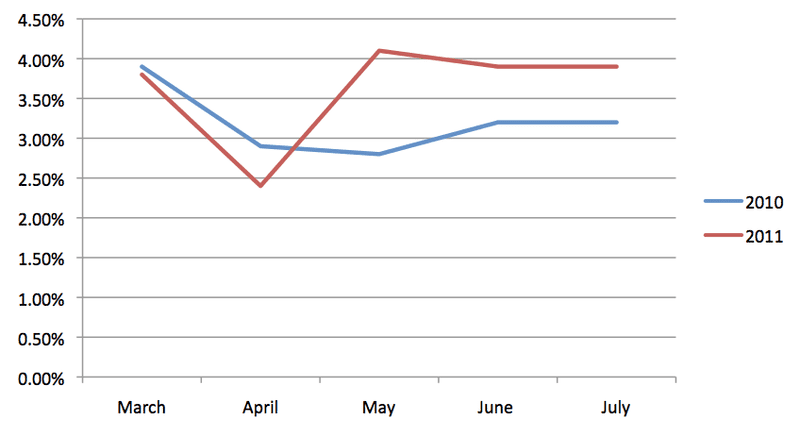Direct debit cancellation rates on the rise
Following my post on the general downturn in DM response rates experienced at the time of the Royal Wedding in April, we have more evidence that this might be the start of a more pronounced trend.
Rapidata has released details of direct debit cancellations for July and they show that the high cancellation rates seen in May and June are continuing to run at approximately 4%.

This might not be as high as we saw in early 2009 when the monthly cancellation rate rose to over 5.5%, but is still a real cause for concern.
It should remind us that we need to focus like a laser beam on giving donors what they need and want in our communications. Even in the toughest times, few donors will cut back their giving completely. Instead they will concentrate their support on the charities that are most relevant to their needs.
Jeff Brooks has some advice on this point that is well worth heeding...
"When you are irrelevant to donors, they seldom complain about it. They just ignore you. Which is far worse than the handful of "too much mail" complaints you're going to get no matter how much or little you mail.
Here are common ways fundraising makes itself irrelevant to donors:
- It's all about the organization -- how wonderful they are in every way. It's not about the donor and her opportunity to change the world.
- It's about things organization insiders care about, not what donors care about. You want to "build sustainable communities." Donors want to save lives. Your work accomplishes both. But the fundraising is aimed at pleasing the insiders.
- It's aimed at the wrong age group. Design, color choice and other elements are what staffers in their 20s and 30s believe they would respond to. It leaves their real donors -- who are typically 60 and up -- out in the cold.
- The segmentation is sloppy. It talks to non-donors as if they're donors -- or vice versa.
- There's no context. The organization only asks, never reports back on the impact of donors' giving."
I'd also like to point out a request for help from Becky Slack of Charity Insight who are monitoring cancellation rates in partnership with Rapidata. She has asked that any organisation who has seen a significant downturn in donations over the last few months to get in touch. Becky can be reached at [email protected].
Tags In
Related Posts
1 Comment
Comments are closed.
The Essentials

Crack the Code to Regular Giving: Insights, Strategies, and a Special Giveaway!

‘Tis Halloween. Keep to the light and beware the Four Fundraisers of the Apocalypse!

Why do people give? The Donor Participation Project with Louis Diez.

A guide to fundraising on the back of a postcard

What does the latest research tell us about the state of fundraising?






Are we sure that Direct Debit cancellations overall are on the rise? Perhaps there are other things that should be considered when looking at the chart. As I understand it, this is based on RapiData client data, so here are some of the questions I’d be asking to try to understand the position a bit more:
•I think this is under 10% of the charity DDs. Are RapiData clients reflective of the sector as a whole? Are larger charities who are processing DDs themselves seeing the same results?
•Are the same charities being looked at year on year? Have some of the RapiData clients changed? This could impact the results.
•Do we have the same definition of a cancellation? I’ve seen some charities that stop a direct debit and start a new one when doing upgrade campaigns or changing the frequency of a donor gift because of their database set-up. Could some of the “cancellations” be upgrades/changes? Could this be why April and December have lower cancellation rates as charities are less likely to do telemarketing campaigns at those times? (people busy/school holidays)
•Have the activities of the RapiData clients changed. For example, many charities find that they have highest attrition rates in the first 3 months of donors recruited via face to face fundraising. Has there been an increase in fundraising on the street or at the doorstep in the group of charities being looked at? This might skew results.
Just some thoughts.